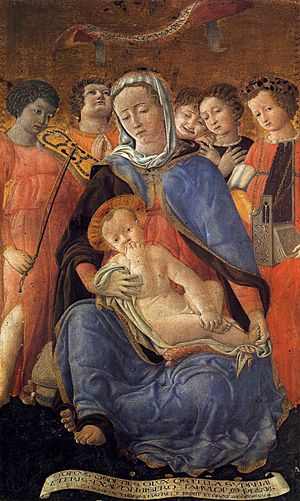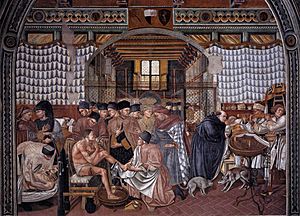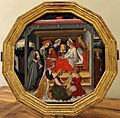Domenico di Bartolo facts for kids
Quick facts for kids
Domenico di Bartolo
|
|
|---|---|
| Born |
Domenico Ghezzi
Asciano, Siena
|
| Died | by 18 February 1446 |
| Known for | Painting |
|
Notable work
|
The Madonna of Humility and Four Music-Making Angels |
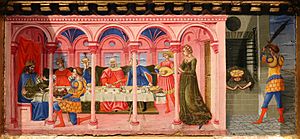
Domenico di Bartolo (born Domenico Ghezzi) was an important painter from Siena, Italy. He was active during the early Renaissance period. He was born in Asciano, near Siena. The famous writer and artist Giorgio Vasari said Domenico was the nephew of another well-known Italian artist, Taddeo di Bartolo.
In the early 1400s, Domenico was one of the Sienese artists who learned a lot from the new style of painting coming from Florence. He was the only Sienese painter of his time to get painting jobs from people in Florence. Domenico also worked with Lorenzo Vecchietta on a famous fresco called The Care of the Sick. This artwork is still seen today in the Pilgrim's Hall at the Santa Maria della Scala (Siena) hospital.
Domenico's name first appears in records in 1420. He was part of a painting project at Siena Cathedral. By 1428, he was officially recognized as a master painter. His first artwork that still exists and has his signature and date is The Madonna of Humility and Four Music-Making Angels from 1433. That same year, he also painted the Virgin and Child Surrounded by Saints.
In 1434, Domenico designed a special floor tile for Siena Cathedral. From 1435 to 1440, he worked on frescoes for the cathedral's sacristy. In 1438, he took a break to paint an altarpiece for a church in Perugia. This altarpiece is now in the Galleria Nazionale dell'Umbria. In 1437, he also agreed to paint an altarpiece for monks in Asciano. By 1439, Domenico was working at the Santa Maria della Scala (Siena) hospital.
The frescoes he painted at the hospital between 1439 and 1440 show scenes from the hospital's history. These works are considered his best. Domenico mostly worked in Perugia and Siena. His only known work outside Siena might have been in Florence. He married Antonia Pannilini in January 1440. By February 1446, Antonia was mentioned as a widow, meaning Domenico had passed away.
Early Life and Training
Domenico di Bartolo was born in Asciano, a town in the Siena province of Tuscany, Italy. His family name was Ghezzi. We don't know his exact birth date, but he was likely born between 1400 and 1405.
A document from 1420 mentions a "Domenico di Bartolo" being paid for his work as a "gharzone di bottega". This means he was likely a helper or apprentice in an art workshop. If this was indeed Domenico, he was just starting his art training. Eight years later, in 1428, he became a recognized master in the painters' guild.
During his early training, Domenico was influenced by many talented sculptors. These included Ghiberti, Donatello, and Jacopo della Quercia. These artists were working on big projects at the Siena Cathedral, like a new baptismal font. Domenico's first painting, the Madonna of Humility from 1433, shows strong influences from sculpture. Art experts believe he learned a lot from these sculptors while working as a helper.
Other painters at the time, like Stefano di Giovanni and Giovanni di Paolo, focused on lines and emotions in their art. Domenico, however, preferred to create figures that looked more rounded and solid.
The Madonna of Humility (1433)
Domenico di Bartolo's Madonna of Humility from 1433 was his first major commissioned artwork. Art experts call it one of the most beautiful works from early Sienese art. The painting shows influences from Masaccio and the sculptor Jacopo della Quercia. Jacopo likely influenced Domenico more directly because they worked together. He might have even helped Domenico create this painting.
This painting is special because it's different from other Sienese paintings of its time. It has strong sculptural qualities, similar to Jacopo della Quercia's style. The painting shows the Madonna (Mary) sitting, looking very solid and strong. Five angels are behind her, forming a half-circle. This makes the painting feel deep and full of movement.
The colors in the painting are also very skillful. The green, pink, and blue of Mary's robes stand out against the pale colors of the angels. This mix of colors was more common in Florentine art. This suggests Domenico learned from someone in Siena who was influenced by Florentine styles. Taddeo di Bartolo is a likely teacher, as he also showed Florentine styles in his art.
Domenico understood Masaccio's realistic style very well. He was able to use Masaccio's ideas in his own paintings without changing them too much. Domenico likely visited Florence in the late 1420s. There, he would have seen Masaccio's paintings. Masaccio was known for making his subjects look lifelike and three-dimensional. Domenico used a technique called "circular-arc composition" in his Madonna of Humility. The angels are arranged in a semi-circle, which creates more space for Mary. This technique helps organize many figures in a simple way.
Domenico's Madonna of Humility also shows influences from Jacopo della Quercia's Madonna in the Fonte Gaia. Both paintings show a new way of painting clothes, with soft shadows that make the figures look heavier and more real. Domenico's painting ended up influencing Florentine art more than Sienese art. At the time, Sienese art critics didn't appreciate it much.
The painting also shows Mary in a way made popular by Gentile da Fabriano, an Italian painter known for his Gothic style. However, many parts of Domenico's painting come from Florentine techniques. For example, the way Mary is shown from the front and the unique halos were rare then. They can be found in Masaccio's works. The baby in the painting also reminds us of Masaccio's work.
Even though Domenico used Florentine styles, art historians still see him as a Sienese painter. He was a young artist open to new ideas, but he hadn't fully made them his own yet. The painting's meaning was influenced by Bernardino da Siena, a famous preacher. The painting's greeting, "Ave Stella Maris" (Hail Star of the Sea), was a special term for Mary that Bernardino wrote about.
The Sigismund Plaque (1434)
In 1434, Domenico also designed a fresco panel for the Siena Cathedral. It showed Sigismund, Holy Roman Emperor on his throne. We don't know the exact date it was finished. Art critics praised this fresco for its Florentine qualities.
Like his Madonna of Humility, this panel also uses a simple semi-circle design. The architecture in the fresco looks good even when viewed from below. Emperor Sigismund is shown much larger than the other figures, like a saint or Madonna. Domenico also used symmetry in the fresco. For example, a man on the left is mirrored by another on the right. These elements appear again in his later works, like the frescoes at the Santa Maria della Scala hospital.
Later Career
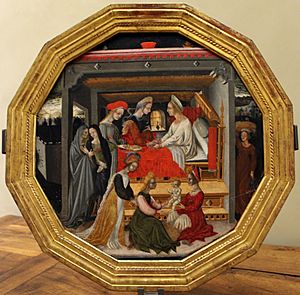
From Domenico's later years, only a few paintings still exist. These include an altarpiece for Santa Giuliana in Perugia, a signed Madonna and Child, and a small Madonna del Refugio in Siena. He also painted frescoes on the walls of the sacristy in Siena Cathedral, but only tiny pieces remain. These frescoes were in such poor condition that their subjects are hard to identify.
Domenico seemed to paint about one fresco per year during this time. He didn't produce much other work. For these cathedral frescoes, he moved away from Florentine influences. Instead, he started using more traditional Gothic styles. This is clear in his 1438 altarpiece for St. Giuliana in Perugia.
From 1440 to 1444, Domenico created one of his most important works. This was a series of frescoes for the pilgrims' hotel in the Ospedale di Santa Maria della Scala (Siena). The hotel's director, Giovanni Buzzichelli, likely hired him. These frescoes show daily life and the history of the Sienese hospital. Domenico was given five scenes to paint.
Siena Cathedral Sacristy Frescoes
Domenico is most famous for his frescoes at the Santa Maria della Scala Hospital. However, his sacristy frescoes for the Siena Cathedral also helped him become known as a rising fresco painter. He started working on these frescoes shortly after his mentor, Jacopo della Quercia, became the director of the cathedral's art restoration. This shows they had a good working relationship. Domenico could only paint one fresco per year for the cathedral. This suggests he was busy with other commissioned works. Sadly, almost none of these cathedral frescoes have survived.
Madonna and Child Enthroned (1437)
In 1437, four years after his Madonna of Humility, Domenico di Bartolo painted a Madonna and Child. Giorgio Vasari believed this painting was part of a larger altarpiece for a church in Florence. The painting's shape suggests it was originally part of a bigger artwork. We don't know exactly where Domenico was living when he painted this piece. It could have been Siena, Florence, or Perugia.
Art experts note that the Madonna and Child figures have a strong, unique quality. Domenico avoided showing elegant beauty, which was popular in Sienese paintings. Instead, he depicted them as simple and humble. There's a clear emotional difference between the child and his worried mother. This painting might have been inspired by Ambrogio Lorenzetti's works. Similarities can be seen in the mother's tender and fearful pose.
Santa Maria della Scala Hospital (1439–1444)
Between 1439 and 1444, Domenico di Bartolo helped decorate the Pilgrim's Hall at the Santa Maria della Scala (Siena) Hospital. He followed the style of artist Lorenzo Vecchietta. Domenico created six frescoes, all signed by him. This five-year project was a big part of his career in his mid-thirties. Sadly, much of the hospital's artwork, including Domenico's, is in poor condition today.
Vecchietta brought a new naturalistic style to Siena. Domenico followed this, but his hospital paintings still showed some Gothic elements. His style mixed ideas from major Florentine artists, a rising Sienese painter, and his own Gothic touches. This shows he understood the new art language of the Renaissance.
Santa Maria della Scala, Siena was one of Europe's first hospitals. It's now a museum and one of the oldest hospital buildings still standing. It was a very rich and powerful place in Siena. The hospital was also a charity. Important citizens and artists helped run it and decorate its wards and church. Earlier artists like Ambrogio Lorenzetti contributed to the hospital's art.
When Domenico worked there, Bartolomeo Bulgarini was in charge of the frescoes. Each fresco showed the hospital's good deeds. Domenico was a smaller contributor, but his six frescoes were unique. They showed strong Sienese elements, making them distinct from Florentine works. During this time, Domenico became more interested in his own native art style.
The frescoes Domenico painted were in the Pellegrinaio di Santa Maria della Scala, which was a ward for sick patients. This hall's art shows how art developed since the hospital was built in 1268. Giovanni di Francesco Buzzichelli, the hospital's head, started the project. He hired both Vecchietta and Domenico di Bartolo. They made the hall's art show lively daily life.
Care of The Sick
Domenico's first fresco in the hospital is called "Care of The Sick." It has his Latin signature and is dated 1440. The fresco shows the inside of a hospital ward in great detail. Doctors and nurses are helping patients and doing other kind acts. In the middle, someone is washing a patient's feet. This reminds us of Christ washing his disciples' feet.
Domenico used bright colors for the costumes and decorations. He followed Vecchietta's style, bringing a new kind of realism to Sienese art. Other painters like Gentile da Fabriano created realistic landscapes, but their images often came from fantasy. Domenico and Vecchietta were new because they painted specific, real places. Domenico's frescoes were also among the first in Sienese art to include visual clues for viewers.
Education and Betrothal of the Foundlings
Domenico's second most famous fresco is "Education and Betrothal of the Foundlings." The painting's design is based on its architecture. It shows children being married under a detailed building with large arches. The figures are placed precisely, with all lines meeting at a single "vanishing" point.
This fresco is special because it uses mathematically accurate space. This was rare in Sienese painting during the early 1400s. Domenico was clearly influenced by Florentine realists like Masaccio and Filippo Lippi. However, art expert Bruce Cole says this fresco is still unique. He calls it a "peculiar blend of realism and fantasy." Small details like floor tiles, rugs, and decorated robes add to its charm.
The Last Fresco
Domenico couldn't finish all six frescoes for the hospital. His relationship with the hospital became difficult because he couldn't complete the sixth fresco. He also couldn't finish a painting called Madonna della Misericordia. Records show that Domenico was put on probation, and his pay was reduced. It's thought that he couldn't finish his work because he became ill. He died shortly after falling sick.
Final Years
Domenico di Bartolo's last known painting job was the fresco of the Coronation of the Virgin. This was for the Palazzo Pubblico in Siena. He started painting four angel heads, but his work was stopped by his death in 1445. Another Sienese artist, Sano di Pietro, finished the fresco after him.
Images for kids
-
Desco da parto with the birth of John the Baptist, 1420-40.
See also
 In Spanish: Domenico di Bartolo para niños
In Spanish: Domenico di Bartolo para niños


